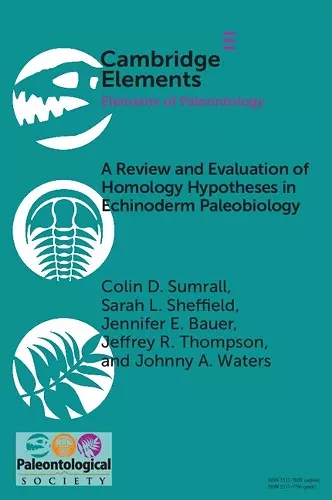A Review and Evaluation of Homology Hypotheses in Echinoderm Paleobiology
Jennifer E Bauer author Sarah L Sheffield author Jeffrey R Thompson author Colin D Sumrall author Johnny A Waters author
Format:Paperback
Publisher:Cambridge University Press
Published:13th Apr '23
Currently unavailable, and unfortunately no date known when it will be back

This Element summarizes decades of research concerning the homology hypotheses structures of Echinodermata.
The extraxial-axial theory (EAT) and universal elemental homology (UEH) are often portrayed as mutually exclusive hypotheses of homology within pentaradiate Echinodermata. The authors of this Element recommend these two hypotheses be used together to generate a better understanding of homology across Echinodermata.The extraxial-axial theory (EAT) and universal elemental homology (UEH) are often portrayed as mutually exclusive hypotheses of homology within pentaradiate Echinodermata. EAT describes homology upon the echinoderm bauplan, interpreted through early post-metamorphic growth and growth zones, dividing it into axial regions generally associated with elements of the ambulacral system and extraxial regions that are not. UEH describes the detailed construction of the axial skeleton, dividing it into homologous plates and plate series based on symmetry, early growth, and function. These hypotheses are not in conflict; the latter is rooted in refinement of the former. Some interpretive differences arise because many of the morphologies described from eleutherozoan development are difficult to reconcile with Paleozoic forms. Conversely, many elements described for Paleozoic taxa by UEH, such as the peristomial border plates, are absent in eleutherozoans. This Element recommends these two hypotheses be used together to generate a better understanding of homology across Echinodermata.
ISBN: 9781009397179
Dimensions: 230mm x 154mm x 5mm
Weight: 150g
54 pages